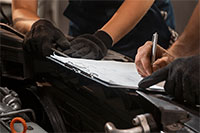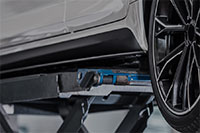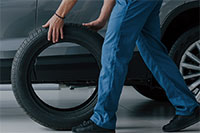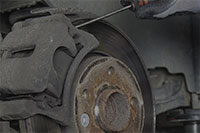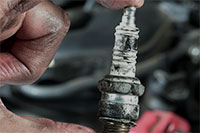Ultimate Guide to Vehicle Maintenance
Everything You Need to Know
download Vehicle Maintenance Checklist (PDF)
download Full Article (PDF)
Welcome to the Ultimate Guide to Vehicle Maintenance by Partly Dave’s Garage, your comprehensive resource for keeping your car running smoothly and reliably for years to come. Whether you're a seasoned car enthusiast or a new driver, understanding the importance of regular maintenance is crucial for ensuring the safety, performance, and longevity of your vehicle.
In this extensive guide, we'll delve into every aspect of vehicle maintenance, from routine tasks like oil changes and tire rotations to more complex issues like engine diagnostics and electrical systems. By following the tips and guidelines provided here, you'll be equipped with the knowledge and confidence to take proactive care of your vehicle and avoid costly repairs down the road.
Let's dive in.
- Creating a Maintenance Schedule
- Routine Maintenance Tasks
- Understanding Your Vehicle's Systems
- Troubleshooting Common Issues and Basic Toolkit
- DIY Maintenance vs. Professional Services
- Vehicle Maintenance Checklist
Creating a Maintenance Schedule
A maintenance schedule is something that is easy to ignore, but the key to effective vehicle maintenance is consistency. It sounds simple, but still requires a bit of a discipline. Create a maintenance schedule based on your vehicle's manufacturer recommendations and your driving habits. Keep track of mileage intervals for tasks like oil changes and tire rotations, and schedule regular inspections to ensure all systems are functioning properly.
Routine Maintenance Tasks
- Oil Changes: Regular oil changes are vital for lubricating the engine and preventing wear and tear on internal components. Firstly, oil changes remove contaminants and debris that can accumulate in the engine over time. These contaminants can cause damage to the engine's internal components, leading to costly repairs or even engine failure. Secondly, engine oil serves to lubricate the moving parts within the engine. Over time, this oil can break down or become contaminated, reducing its effectiveness as a lubricant. This can lead to increased friction between engine components, which can cause overheating and potentially serious damage. Fresh oil ensures that the engine is properly lubricated, reducing friction and heat, and extending the life of the engine. And thirdly, regular oil changes can help you improve fuel efficiency. When an engine is running with old or contaminated oil, it has to work harder, which can decrease fuel efficiency. Fresh oil allows the engine to run more smoothly and efficiently, potentially saving you money on fuel costs. If you’re curious to find out more about the oil changes, you’re welcome to read another article we wrote here.
- Tire Care: Check tire pressure regularly and inspect for signs of wear or damage. Rotate tires every 8,000 to 11,000 kms to ensure even wear and prolong tire life. Proper tire maintenance is essential for your safety and the safety of others on the road. Underinflated or overinflated tires, uneven wear, or damage can lead to a blowout or loss of control of the vehicle. Regular tire checks can help identify these issues before they become dangerous. Properly inflated tires can improve your vehicle's fuel efficiency. Underinflated tires increase rolling resistance, which requires more energy (and thus more fuel) to move the vehicle. Overinflated tires can reduce traction and lead to uneven wear. Regular tire checks can help extend the life of your tires. By ensuring they are properly inflated and rotated, you can prevent uneven wear and maximize their lifespan. This can save you money in the long run by reducing the frequency of tire replacements. And finally, proper tire maintenance can improve your vehicle's handling and performance. Tires with the correct air pressure and tread depth provide better grip and stability, particularly in adverse weather conditions. If you’re curious to find out more, we have another article dedicated to winter tires.
- Fluid Checks and Replacements: Check and top off fluids such as coolant, brake fluid, power steering fluid, and windshield washer fluid regularly. Replace fluids according to manufacturer recommendations. Regular oil and fluid checks ensure that the engine is lubricated properly. Clean oil and fresh filters can help prevent engine wear, reduce friction, and keep the engine running smoothly. This extends the life of the engine and improves its overall performance. Brake fluid absorbs moisture over time, which can lead to corrosion in the brake system. Regular checks and replacement of brake fluid help maintain the efficiency and safety of the braking system. Transmission fluid ensures smooth gear shifts and helps to cool the transmission. Checking and replacing transmission fluid can prevent costly transmission repairs and extend the life of the transmission. Coolant, or antifreeze, prevents the engine from overheating in the summer and freezing in the winter. Regular checks and replacements help maintain the coolant system and prevent damage to the engine due to extreme temperatures. Power steering fluid lubricates the power steering system, making it easier to steer the car. Regular checks and replacements can prevent power steering system failures and ensure smooth steering. And finally :) the windshield washer fluid which is crucial for maintaining visibility while driving. Regular checks and refills ensure that the windshield can be cleaned effectively, especially during adverse weather conditions.
- Battery Maintenance: The primary function of a car battery is to provide the necessary power to start the engine. A weak battery can prevent the car from starting, making it essential to keep the battery in good condition to ensure the vehicle is operational when needed. In addition to starting the engine, the car battery also powers all the electrical components in your vehicle. These include the lights, radio, air conditioning, and any other electrical systems. A well-maintained battery ensures these components function properly. Regular battery maintenance, such as checking the voltage and cleaning the terminals, can help extend the battery's life. On average, a traditional car battery has a reliable service life of about three years or 36 months with proper maintenance. And maintaining your car battery can save you money in the long run. Replacing a battery can be expensive, and neglecting maintenance may lead to more frequent replacements. A well-maintained battery reduces the risk of being stranded due to a dead battery, enhancing your safety on the road, which is important, right?
- Filter Replacements: Let’s break this down to four filter types. Engine Air Filter ensures that the air entering the engine is clean and free of particles that could damage the engine. A clogged air filter can reduce fuel efficiency, decrease acceleration, and cause the engine to work harder, potentially leading to increased emissions and decreased engine life. Cabin Air Filter cleans the air that enters the vehicle's cabin. It captures dust, pollen, and other particles, improving the air quality for the vehicle occupants. A dirty cabin air filter can result in reduced airflow and decreased heating or cooling efficiency. It may also lead to unpleasant odors in the vehicle. Fuel Filter removes impurities from the fuel before it reaches the engine. A clogged fuel filter can lead to poor engine performance, reduced fuel efficiency, and potentially damage the fuel pump and injectors. And finally, Oil Filter removes contaminants from the engine oil to keep the engine lubricated and running smoothly. A dirty oil filter can lead to increased wear and tear on engine components and decreased engine life.
Understanding Your Vehicle's Systemss
Familiarizing yourself with the various parts of your car can be incredibly beneficial for several reasons. It can help you understand how your car operates, detect potential issues early, and even save you money by performing basic maintenance tasks yourself. You can consult your car's owner's manual, which usually provides detailed information about each component and how to maintain them. Additionally, you can find online resources, tutorials, and videos that explain how these systems work and how to perform basic maintenance tasks. Obviously, you don’t have to do this, and can always get help from someone like us, but it can still prove to be very beneficial. Here's a brief overview of each system:
- Engine: The engine is the heart of your car, converting fuel into energy to power the vehicle. Learning about the engine can help you understand how to maintain it properly, such as regular oil changes, air filter replacements, and spark plug maintenance. This can prolong the life of your engine and improve fuel efficiency.
- Transmission: The transmission transfers power from the engine to the wheels, allowing you to control the speed and torque of the vehicle. Understanding the basics of your transmission can help you identify potential issues, such as slipping gears or delayed shifting, which can lead to costly repairs if not addressed promptly.
- Braking System: Brakes are critical for safety, and understanding how they work can help you maintain them properly. This includes checking brake fluid levels, inspecting brake pads for wear, and ensuring the brake rotors are smooth and free of rust. Regular brake maintenance can prevent accidents and save you money on repairs.
- Suspension and Steering: The suspension system and steering components work together to provide a smooth and safe driving experience. Familiarizing yourself with these systems can help you identify issues like uneven tire wear, poor alignment, or worn shocks and struts. Addressing these issues can improve handling, extend the life of your tires, and make your ride more comfortable.
- Electrical System: The electrical system powers various components in your car, such as the lights, radio, and engine control unit. Understanding the basics of this system can help you troubleshoot issues like dim headlights, dead batteries, or malfunctioning electronics. This knowledge can save you time and money by allowing you to diagnose and fix simple problems yourself.
- Cooling System: The cooling system is responsible for maintaining the engine's temperature and preventing overheating. Familiarizing yourself with the components, such as the radiator, coolant hoses, and thermostat, can help you identify potential issues like leaks or low coolant levels. Regular maintenance of the cooling system can prevent costly engine damage and keep your car running smoothly.
Troubleshooting Common Issues
It's important to be prepared for car issues because it can help you save time and money. By understanding common issues and knowing how to diagnose them, you can potentially fix minor problems yourself, preventing them from becoming more significant and costly issues. Being prepared can also help you avoid getting stranded due to a car breakdown, especially if you know how to perform basic maintenance tasks and can identify potential problems before they become serious. The most common car troubleshooting issues include:
- Dead Battery: A dead battery is often due to leaving lights on, a faulty alternator, or simply an old battery.
- Starter Motor Issues: If you turn the key and hear a clicking sound, it might indicate problems with the starter motor.
- Overheating: An overheating engine can lead to serious damage. This can be caused by a low coolant level, a broken water pump, a faulty radiator, or a broken drive belt, among other issues.
- Warning Lights: Dashboard warning lights can indicate various problems, such as low oil pressure, low tire pressure, or issues with the engine or emissions systems.
- Brake Problems: Issues with brakes can range from worn brake pads to a leak in the brake fluid system.
- Electrical Issues: These can be caused by a variety of factors, including faulty wiring, blown fuses, or problems with the battery.
- Flat Tires: This can be caused by a puncture or wear and tear.
- Steering Wheel Shakes: This can be caused by unbalanced, cracked, or buckled wheels, a deflated or damaged tire, a loose wheel bolt, a faulty wheel bearing, or even a worn suspension bushing.
- Engine Misfires: This can be caused by a variety of issues, including faulty spark plugs, a clogged fuel filter, or problems with the fuel system.
- Oil Leaks: These can be caused by a variety of factors, including a worn oil filter, a damaged oil pan, or a faulty valve cover gasket.
- Engine Overheating: This can be caused by a variety of issues, including a low coolant level, a broken water pump, a faulty radiator, a broken drive belt, or low engine oil.
- Alternator Issues: A faulty alternator can lead to battery issues and electrical failures.
- Faulty Sensors: Modern cars have various sensors, and a malfunction in any of them can lead to a variety of issues, from poor fuel economy to engine misfires.
To prepare for troubleshooting common issues in a car, you should familiarize yourself with the basic systems of a car and their functions. This includes understanding the engine, transmission, braking system, suspension and steering, electrical system, and cooling system. Additionally, having a basic toolkit and knowing how to use it can be very helpful in diagnosing and resolving some common issues. Here's a list of tools and equipment that can be part of such a toolkit:
- Socket and Ratchet Set: This is crucial for working on various nuts and bolts in the engine compartment and elsewhere on the vehicle.
- Screwdrivers: A set of screwdrivers in various sizes and types (e.g., flathead, Phillips) is essential for a wide range of tasks.
- Pliers: A good set of pliers can help in many situations, from gripping and twisting to cutting wires.
- Wrenches: An adjustable wrench, as well as a set of combination wrenches in common sizes, are important for loosening and tightening nuts and bolts.
- Multimeter: This tool is indispensable for diagnosing electrical issues, such as checking battery voltage and testing fuses.
- Flashlight or Headlamp: A source of light is crucial for working in dark or dimly lit areas under the hood or under the car.
- Duct Tape: This versatile tool can be used for quick fixes, such as holding a loose hose in place or temporarily securing a loose part.
- Jumper Cables: These are essential for jump-starting a car with a dead battery.
- Gloves and Safety Glasses: These are important for protecting your hands and eyes while working on the car.
- Jack and Jack Stands: A jack and jack stands are necessary for safely lifting and supporting the vehicle for tasks such as changing a tire or working underneath the car.
- Oil Filter Wrench: This tool is specifically designed to remove and install oil filters, which is important for regular maintenance tasks like oil changes.
- Tire Pressure Gauge: This tool is essential for checking and maintaining the correct tire pressure, which is important for safety and fuel efficiency.
- Brake Cleaner: This is useful for cleaning brake parts and other components that get dirty or greasy during maintenance.
- Shop Towels or Rags: These are necessary for cleaning up spills and messes, as well as for general cleaning and maintenance tasks.
We can also recommend looking into our Understanding Car Tune-Ups article.
DIY Maintenance vs. Professional Services
When deciding between DIY car maintenance and professional services, it's essential to consider several factors including your skill level, the complexity of the task, the cost of tools and parts, and the potential risks involved.
DIY Car Maintenance Pros:
- Can save you money, especially on routine tasks like oil changes and air filter replacements.
- Provides a sense of accomplishment and can help you better understand your vehicle. Why not?
- Can be convenient if you have the necessary tools and knowledge.
DIY Car Maintenance Cons:
- Some tasks may require specialized tools that can be expensive to buy or rent.
- If you don't have the necessary skills or knowledge, you could potentially damage your vehicle, leading to more expensive repairs down the line.
- Certain tasks, like brake replacements or engine diagnostics, can be complex and dangerous if not performed correctly.
Professional Car Maintenance Pros:
- Professional mechanics have the training and experience to diagnose and fix even the most complex problems.
- Professional services often come with warranties, providing peace of mind.
- Professionals have access to specialized tools and equipment that most DIYers don't have.
Professional Car Maintenance Cons:
- Can be more expensive, especially for routine maintenance tasks.
- You'll need to take your vehicle to a shop and potentially wait for the work to be completed, which can be inconvenient.
Ultimately, the decision between DIY and professional car maintenance is yours to make and depends on your personal situation. For simple tasks that you're confident in performing, DIY can save you money and provide a sense of satisfaction. However, for complex or critical repairs, it's often best to leave the work to a professional mechanic.
Recommended Vehicle Maintenance Checklist
(you can also download it in the PDF format)
Every 10,000 km:
- Check the engine oil and oil filter.
- Check the tire pressure and tread depth.
- Inspect the brakes and brake fluid.
- Check all lights and signals.
- Inspect the battery and battery terminals for corrosion.
- Check and top off windshield washer fluid, coolant, transmission fluid, power steering fluid.
- Inspect the belts and hoses for wear or damage.
- Inspect the exhaust system for leaks.
- Check the suspension and steering components for wear.
Every 30,000 km:
- Change the oil and oil filter.
- Check the air filter and replace if necessary.
- Check the tire pressure and tread depth.
- Inspect the brakes and brake fluid.
- Check all lights and signals.
- Check the battery and battery terminals for corrosion.
- Inspect and top off windshield washer fluid, coolant, transmission fluid, power steering fluid.
- Inspect the belts and hoses for wear or damage.
- Inspect the exhaust system for leaks.
- Check the suspension and steering components for wear.
Every 60,000 km:
- Replace the air filter.
- Inspect the spark plugs and replace if necessary.
- Inspect the fuel system, including the fuel filter and fuel pump.
- Check the engine's timing and adjust if necessary.
- Inspect the engine for leaks, wear, and other issues.
Seasonal Maintenance:
- Check the air conditioning system before summer.
- Check the heating system before winter.
- Check the windshield wipers and replace if necessary.
- Inspect the tires for wear and rotate them.
- Check the alignment and balance of the wheels.
Annual Maintenance:
- Check the air conditioning system.
- Check the heating system.
- Check the windshield wipers and replace if necessary.
- Inspect the tires for wear and rotate them.
- Check the alignment and balance of the wheels.
Long-Term Maintenance (Every 60,000 - 120,000 km):
- Replace the timing belt.
- Replace the water pump.
- Inspect and possibly replace the drive belts.
- Check and possibly replace the shock absorbers.
- Inspect and possibly replace the brake rotors and pads.
As always, we hope you find our guides helpful and enjoyable. If you reside in Vernon or nearby communities and are in need of car tune-up services, we invite you to schedule an appointment with us. Be safe.



